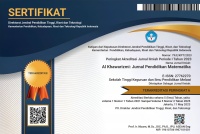ANALISIS KEMAMPUAN LITERASI NUMERASI SISWA KELAS VII DALAM MENYELESAIKAN SOAL CERITA ALJABAR
DOI:
https://doi.org/10.46368/kjpm.v5i1.2515Abstract
Abstrak: Artikel ini menjelaskan tentang kemampuan literasi numerasi siswa kelas VII saat menyelesaikan soal cerita pada materi aljabar. Penelitian ini dilakukan di MTs Tarbiyatul Aulad yang berlokasi di Desa Perdopo Kecamatan Gunungwungkal Kabupaten Pati dengan jumlah subjek penelitian sebanyak 33 siswa. Data diperoleh dari tes kemampuan literasi numerasi dan wawancara, kemudian data dianalisis menggunakan pendekatan kualitatif studi deskriptif. Hasil penelitian menunjukkan bahwa kemampuan literasi numerasi sebesar 33 siswa menunjukkan kategori baik dengan nilai rata-rata 84,5. Siswa dengan nilai tertinggi dapat memenuhi dua sampai tiga indikator, sedangkan siswa dengan nilai tes keterampilan literasi numerasi yang rendah hanya memenuhi satu tes indikator. Tidak terpenuhinya indikator disebabkan oleh kesalahan siswa antara lain : 1) Tidak menuliskan informasi data yang diketahui dan ditanyakan, 2) Salah dalam menyelesaikan permasalahan, 3) Salah dalam menghitung, dan 4) Tidak menuliskan kesimpulan hasil jawaban yang diperoleh.
Â
Kata Kunci: kemampuan literasi numerasi, aljabar, soal cerita.
 Â
Â
Abstract : This article describes junior high school students' literacy numeracy skills in solving story problems on algebra. The research was conducted at private junior high school located in Perdopo, Gunungwungkal, Pati with 33 students research subjects. The data were obtained through the literacy numeracy skills test and interview results, and then the data were analyzed using a qualitative descriptive study. The results showed that the literacy numeracy skills of 33 students showed an good category with an average score of 84,5. Students with the highest score can fulfilled two to three indicators, while students with low score of literacy numeracy skills test only fulfilled one indicator. The unfulfillment of indicators is caused by student errors include: 1) Not writing known data information and asked, 2) Wrong in solving the problem, 3) Wrong when calculating, and 4) Not writing conclusions on the results of the answers obtained.
Â
Keywords: literacy numeracy skills, algebra, story problems. Â
Â
References
Ayuningtyas, N. (2020). Analisis Pengetahuan Numerasi Mahasiswa Matematika Calon Guru. Delta-Pi : Jurnal Matematika Dan Pendidikan Matematika, 9(2). http://ejournal.unkhair.ac.id/index.php/deltapi/article/view/2299
Badi’ah, I. (2020). Pengaruh Model Pembelajaran Knisley terhadap Kemampuan Pemahaman Konsep Matematis ditinjau dari Literasi Numerasi. WILANGAN : Jurnal Inovasi Dan Riset Pendidikan Matematika, 1(3). https://jurnal.untirta.ac.id/index.php/wilangan/article/download/8966/pdf_16
De Lange, J. (2006). Mathematical Literacy for Living from OECD-PISA Perspective. Tsukuba Journal of Educational Study in Mathematics, 25. http://www.human.tsukuba.ac.jp/~mathedu/2503.pdf
Fauziah, R. (2019). Scaffolding pada Pemecahan Masalah Soal Cerita Bentuk Aljabar di Kelas VII-A MTs Al-Ma’rifat Tulungagung Tahun Ajaran 2018/2019. IAIN Tulungagung.
Han, W., Susanto, D., Dewayani, S., Pandora, P., Hanifah, N., Miftahussururi, Akbari, Q. S. (2017). Materi Pendukung Literasi Numerasi. https://gln.kemdikbud.go.id/glnsite/wp-content/uploads/2017/10/materi pendukung-literasi-numerasi-rev.pdf
Hartatik, S., & N. (2020). Kemampuan Numerasi Mahasiswa Pendidikan Profesi Guru Sekolah Dasar dalam Menyelesaikan Masalah Matematika. Education and Human Development Journal, 5(1). https://doi.org/10.33086/ehdj.V5i1.1456
Karmila. (2018). Deskripsi Kemampuan Literasi Matematis Siswa Ditinjau dari Gender. Pedagogy, 3(1). https://doi.org/10.30605/pedagogy.v3i1.956
Larasaty, B. M., Mustiani, & Pratini, H. S. (2018). ). Peningkatan Kemampuan Literasi Matematika Siswa Kelas VIII SMP Bopkri 3 Yogyakarta Melalui Pendekatan PMRI Berbasis PISA pada Materi Pokok SPLDV. Prosiding Seminar Nasional Etnomatnesia, 622–633.
Mahmud, M. R., & Pratiwi, I. M. (2019). Literasi Numerasi Siswa dalam Pemecahan Masalah Tidak Terstruktur. KALAMATIKA Jurnal Pendidikan Matematika, 4(1), 69–88. https://doi.org/10.22236/kalamatika.vol4no1.2019pp69-88
Maulidina, A. P., & Hartatik, S. (2019). Profil Kemampuan Numerasi Siswa Sekolah Dasar Berkemampuan Tinggi dalam Memecahkan Masalah Matematika. Jurnal Bidang Pendidikan Dasar, 3(2), 61–66. https://doi.org/https://doi.org/10.21067/jbpd.v3i2.3408
Mustain, I. (2015). Kemampuan Membaca dan Interpretasi Grafik dan Data: Studi Kasus pada Siswa Kelas 8 SMPN. Scientiae Educatia, 5(2). https://doi.org/https://doi.org/10.24235/sc.educatia.v4i2.493
OECD. (2019). PISA 2018 Results (Volume I): What Students Know and Can Do. OECD Publishing. https://doi.org/https://doi.org/10.1787/5f07c754-en
Rahardjo, M., & Waluyati, A. (2011). Pembelajaran Soal Cerita Operasi Hitung Campuran di Sekolah Dasar. http://p4tkmatematika.org/file/Bermutu 2011/SD/9.PEMBELAJARAN SOAL CERITA OPERASI HITUNG.pdf
Sari, P. P., Hasbi, M., & Umam, K. (2017). Analisis Kesalahan Siswa menurut Newman dalam Menyelesaikan Soal Cerita Matematika Materi Aljabar Kelas VIII SMPN 1 Banda Aceh. Jurnal Ilmiah Mahasiswa Pendidikan Matematika, 2(2), 81–90. http://jim.unsyiah.ac.id/pendidikan-matematika/article/view/2826
Setiawan, A., Inganah, S., & Ummah, S. K. (2019). Analisis Kemampuan Literasi Matematis Siswa dalam Penyelesaian Soal Pisa Ditinjau dari Gender. Jurnal Karya Pendidikan Matematika, 6(1), 43–48. https://doi.org/https://doi.org/10.26714/jkpm.6.1.2019.43-48
UNESCO. (2006). Literacy for Life. https://unesdoc.unesco.org/ark:/48223/pf0000141639
Downloads
Additional Files
Published
How to Cite
Issue
Section
Citation Check
License
Authors who publish with this journal agree to the following terms:
1. Authors retain copyright and grant the journal right of first publication with the work simultaneously licensed under a Creative Commons Attribution License that allows others to share the work with an acknowledgement of the work's authorship and initial publication in this journal.
2. Authors are able to enter into separate, additional contractual arrangements for the non-exclusive distribution of the journal's published version of the work (e.g., post it to an institutional repository or publish it in a book), with an acknowledgement of its initial publication in this journal.
3. Authors are permitted and encouraged to post their work online (e.g., in institutional repositories or on their website) prior to and during the submission process, as it can lead to productive exchanges, as well as earlier and greater citation of published work.






